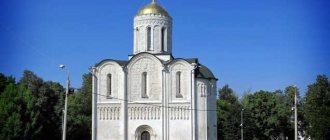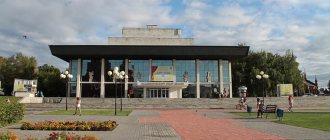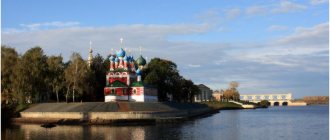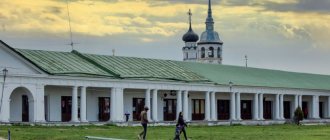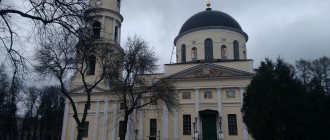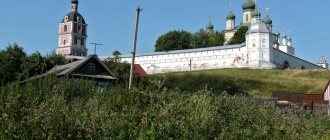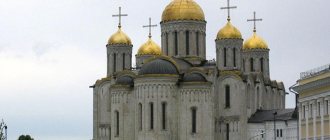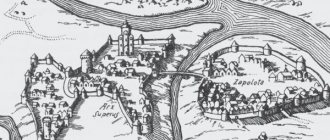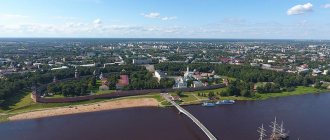| First day Second day Museums of Vladimir Excursions Stories, routes and tips from tourists with photos Where to stay in Vladimir Excursions from Vladimir for 2 days |
Ancient Vladimir is one of the most interesting cities of the Golden Ring. Despite the status of the regional capital, Vladimir has retained the charm of the ancient city: white stone churches, wooden huts, stone mansions. Over its centuries-old history, the city has been the capital of Rus' - now the historical architecture of Vladimir is included in the UNESCO World Heritage List.
2 days in Vladimir is a perfectly acceptable time to explore the city’s attractions and surrounding areas. The main thing is to identify interesting places for yourself in advance and plan your route by the hour.
Monument “850 years of Vladimir” Photo: © Katerina Solosyatova
First day
The sights of Vladimir are easily covered in 2 days. Travelers usually devote the first day to a walk around the Oktyabrsky district, within which the largest number of architectural monuments and museums of Vladimir are concentrated. The length of the route is short, but due to the abundance of attractions, a walk around the city can take a whole day.
Mother of God Nativity Monastery
This is the first major attraction that tourists see when arriving in the city by train or bus. The holy monastery was built at the end of the 12th century by order of Prince Vsevolod the Big Nest. In the first century and a half of its existence, the monastery was the center of monastic life in North-Eastern Rus'. This is where the Laurentian Chronicle comes from. The original buildings of the monastery have not survived - they were dismantled during Soviet times. The cathedral and bell tower were restored in post-Soviet times.
Details: Mother of God Nativity Monastery
Mother of God Nativity Monastery Photo: © Oksana Gordeeva
Dmitrievsky Cathedral
Moving towards the city center, you will come to a small openwork temple. Dmitrievsky Cathedral of the end of the 12th century certainly appears in the lists of “What to see in Vladimir in 2 days.” The white stone building is notable for its carved walls: more than 600 bas-reliefs with historical and mythological subjects are carved on the outside. The interior decoration is also remarkable: fragments of frescoes from the 12th century have been preserved on the walls. Also kept here is a piece of clothing with the blood of the martyr Demetrius of Thessaloniki - it was in honor of this saint that the cathedral was named.
Details: Demetrius Cathedral
Dmitrievsky Cathedral Photo: © dualia1
Chambers
of the Chambers of Representatives is located near the Dmitrievsky Cathedral . In past centuries, the provincial administration was located here, and now museum exhibitions are located here. The most interesting collection inside is an exhibition of Russian painting. The collection features works from medieval masters to contemporary artists. The chambers are surrounded by the green park area “Lipki” - both tourists and the townspeople themselves like to relax here.
Details: Chambers
Chambers building Photo: © Oksana Gordeeva
Assumption Cathedral
The main Orthodox attraction of Vladimir is the Assumption Cathedral . The temple was founded by Andrei Bogolyubsky in 1158. For centuries, this massive monument of Russian white-stone architecture was the place where the rulers of Vladimir and Moscow were married into the principality. Don't limit yourself to an external inspection; inside the cathedral, fragments of Andrei Rublev's frescoes have been preserved. Since the Assumption Cathedral is still active, you can visit it during services. Also, daily (except Mondays) excursions are held with a story about the history and surviving paintings.
Details: Assumption Cathedral
Assumption Cathedral Photo: © Oksana Gordeeva
Observation deck on Cathedral Square
In front of the Assumption Cathedral lies Cathedral Square with an observation deck. The observation deck is notable not only for its picturesque view of the Klyazma River and the surrounding area, but also for the monument to Prince Vladimir . The opening of the monument in 2007 was timed to coincide with the 850th anniversary of the transfer of the capital of the principality from Suzdal to Vladimir. The square and the cathedral are framed by a small park named after Pushkin . Take a walk around - there are several more notable monuments in the park: Andrei Rublev and the monument in the style of socialist realism “850 years of Vladimir” .
Observation deck in front of the Assumption Cathedral Photo: © dualia1
Golden Gate
Along one of the main streets of the city, Bolshaya Moskovskaya, you will come to the Golden Gate . Walking around Vladimir on your own in 2 days, you will pass by the white stone gates with the gate church more than once. The monument, unique for Russia, was erected in 1164 by order of Andrei Bogolyubsky. In those days, the gate was used as a defensive structure and a ceremonial entrance to the city. You can also explore the Golden Gate from the inside: within the walls of the gate church there is an exhibition dedicated to the defense of Vladimir during the capture of the city by Batu Khan. In addition to a large-scale defense diorama, a collection of ancient weapons from the medieval period is exhibited here.
Details: Golden Gate
Golden Gate Photo: © Katerina Solosyatova
Patriarchal Garden
From the Golden Gate it is worth climbing Kozlov Val , which was once a defensive structure. Next you need to move towards Klyazma along Kozlov Val Street towards the Patriarchal Garden . The road will pass by the private sector - charming wooden houses with vegetable gardens. A visit to the garden is paid (150 rubles). More than 100 types of fruit and berry crops are planted here. The topography of the park is also interesting - the elevation differences in some parts reach 33 meters. In front of the garden there are several funny sculptures for tourist photos: a monument to the Vladimir Cherry and the Scientist Cat .
At the entrance to the Patriarchal Garden Photo: © dualia1
At the end of the day you can drive to the Central Park of Culture and Recreation . One of the tallest Ferris wheels in Russia is located here. The attraction is called "Sky 33" . The wheel rises to a height of 50 meters. 1 session lasts 15 minutes.
Detailed route: What to see in Vladimir in 1 day
View from the Sky 33 Ferris wheel Photo: © Oksana Gordeeva
Home page| Vladimir region |
Vladimir...
Vladimir. City center
On the one hand, there is an ancient Russian city, on the other, a city with which a certain, quite long period of life of the author of these lines is associated, on the third, if we follow the principle of organizing this site, the place of stay of a forced tourist under a certain time limit... It is from these positions that we will try to take you on a short excursion program around the city that is part of the famous Golden Ring...
Like most of our fellow citizens, we prefer to travel by car... Now I will not go into the geographical features of the city’s location (how many kilometers from Moscow, on which federal highway it is located, or, as is now fashionable, indicate coordinates for a GPS navigator. You can also make a connection to Klyazma, etc., etc.). I hope that everyone who wants to visit this city will get there without any problems. After all, this is a regional center...
The problem usually arises with a parking space, which would preferably be located in such a way that it would be convenient to see all the sights and at the same time spend as little as possible your precious calories. Although for some who are concerned, for example, with a problem with their own weight, this issue may not be so relevant...
But, as a rule, a person is a fairly rational and very lazy creature, so you still want to leave the car in close proximity to one or another attraction...
In my opinion, in Vladimir (at the time of our visit) one could find a lot of such places - many local drivers do just that... (of course, you shouldn’t be too impudent and leave your car at the entrance to the Reception of the President of the Russian Federation, which is located directly at the Golden Gate ). But you and I are law-abiding citizens, and even with out-of-town license plates - we park in such a way as not to violate traffic rules...
One such very secluded and cozy place is located at the beginning of Oktyabrsky Avenue adjacent to Dvoryanskaya Street, which was once called Moskovskaya….
Leaving the car alone, we cross Dvoryanskaya Street and before our eyes the famous Golden Gate...
Vladimir. City center
In order to optimize our route, we ignore this architectural monument for now, cross to the other side of Dvoryanskaya Street and head to a rather unusual building for this region - the Church of the Rosary of the Mother of God...
Vladimir. City center
The church, designed by architects A.P. Afanasyev and I.O. Karabutov in a pseudo-Gothic style, appeared in 1891-1892.
Already by 1902, the parish numbered over 1000 believers, with no more than 370 city parishioners (all the rest were residents of surrounding villages. Mostly they were either workers or military personnel of Polish, Lithuanian and German nationalities...
In December 1930, the Soviet government decided to liquidate the Roman Catholic Church in Vladimir. The building is required to house the city library... Subsequently, experts from the councils decided that the bell tower of the church was quite suitable for housing a repeater, and the canon’s house was turned into a communal apartment, where, according to various sources, from 8 to 12 families lived... Later (in the 70s years of the last century) a decision was made to use the church as an exhibition hall...
Only in 1992 the church was returned to Catholics again and now regular services are held here...
Vladimir. City center
In fact, opposite the church there is another monument, but of Soviet architecture - the Vladimir Drama Theater named after Lunacharsky. It was erected in 1971, and the team of its authors was awarded the State Prize of the RSFSR. They say that the theater's repertoire currently consists of almost 30 performance titles... However, if my memory serves me right, in the early 80s it was famous for the fact that grandiose discos organized by students of the Vladimir Polytechnic University took place in its foyer in the evenings...
Vladimir. City center
And in front of the masterpiece of Soviet architecture is one of the last religious buildings of pre-revolutionary Vladimir - the Trinity Church.
It was erected with donations from wealthy Old Believers in 1916 and dedicated to the 300th anniversary of the Imperial House of Romanov. The author of the project is architect S.M. Zharov. Its location testifies to the great influence (or ability to negotiate) of the Old Believers on local authorities at that time - not everyone will be allowed to build a church in the immediate vicinity of the Golden Gate...
Vladimir. City center
Because of its appearance, it received its popular name - “Red Church”. Services here continued until 1928, and in the 60s. They wanted to demolish it altogether - they wanted to expand the area in front of the Golden Gate. The writer V.A. then joined the active struggle for the survival of the Trinity Church. Soloukhin and other figures of real culture. Thanks to them, the church was left alone. In the early 70s of the last century, restoration work took place there and in May 1974 the exhibition of the Vladimir-Suzdal Museum “Crystal. Lacquer miniature. Embroidery”, which is still open today. So if this topic is interesting to you, everything is in your hands...
Vladimir. City center
Well, we are heading to perhaps the main attraction of Vladimir - the Golden Gate - a worthy monument to Russian military architecture from the time of Andrei Bogolyubsky, built in 1164.
At their core, they were multifunctional: on the one hand, they are part of the city’s defensive structures, on the other, a kind of triumphal arch through which Prince Andrei returned to Vladimir after numerous military victories or his honored guests entered, on the third, the main entrance to the noble part of the city, where the princes and boyars lived...
In its original form, the gate arch was covered with oak doors trimmed with gilded copper. In connection with this, the gate was nicknamed Golden...
Unfortunately, those gates have not been completely preserved to this day: first in 1238, during a Tatar raid, they suffered greatly, then in the 17th century, then a fire in 1778. But the main changes in their appearance occurred during the reign of Catherine II, who approved the development plan for Vladimir. According to this plan, it was necessary to remove the ramparts, widen the road and modernize the gates in such a way that not a trace remained of their defensive function... Which was successfully done. However, despite this, the Golden Gate of Vladimir is unique even for the reason that similar ones in Jerusalem, Constantinople or Kiev have not survived to this day at all...
For the last 50 years, the Golden Gate has been an architectural component of the Vladimir-Suzdal Museum-Reserve. Various exhibitions are currently located in the gate church and on the battle site... If you have time, you can see here a diorama of the assault by Batu Khan’s troops on the city in 1238, and get acquainted with the weapons and equipment of the 13th-19th centuries, as well as the achievements of the famous gunsmith designers from Kovrov - Degtyarev and Simonov. There is also a display case with things belonging to cosmonaut V.N. Kubasova...
Vladimir. City center
Near the Golden Gate, part of the fortress rampart has survived to this day...
This is where we climb...
Vladimir. City center
From here, from the very edge of the rampart, you can once again examine the Golden Gate in detail and from a different perspective,
Vladimir. City center
and the “Red Church” with the surrounding areas...
Vladimir. City center
If you have already examined everything from this point, turn 180 degrees and move to another red brick structure...
In 1860, when laying the city water supply system, the need arose for a water tower that would provide water to the city fountain on Cathedral Square and 6 city water pumps. Initially, it was planned to use the gate church of the Golden Gate as a water tower, and work has already begun. But due to a tragic incident - several workers fell asleep during excavation work - the commission considered the church to be a rather dilapidated structure, unable to withstand reconstruction... And then, on Kozlovy Val, in 1866, according to the design of Karl Dill, a new water tower with a reservoir for 8000 buckets was built... In In 1912 it was rebuilt according to the design of S.M. Zharova operated successfully until the 50s of the last century until the time came for the reconstruction of the city water supply. The tower is boarded up and it turns into a homeless shelter...
In 1967, the tower was seen as a monument to regional urban planning and architecture. In 1971, it was transferred to the Vladimir-Suzdal Museum-Reserve and, under the leadership of the architect S. Ermolin, its re-equipment began: a spiral staircase was built, an observation deck was installed instead of a flat roof, etc., and on May 1, 1975, an exhibition dedicated to the provincial Vladimir at the end of the 19th - beginning of the 20th centuries.
Vladimir. City center
After getting acquainted with this architectural monument of local significance, do not rush to go back, but look to the left (in the literal sense of the word) - you will not regret it.
Firstly, you will see the Church of the Transfiguration of the Savior (late 18th century), located on the site where in 1164 Prince Andrei Bogolyubsky founded his princely court and built the Church of the Savior, which resembled the Church of the Intercession on the Nerl...
Vladimir. City center
Near the Church of the Transfiguration of the Savior you will see a miniature Church of St. Nicholas with an original bell tower in the form of a square tower...
Vladimir. City center
and a memorial chapel in memory of the 2000th anniversary of Christianity, consecrated by Archbishop of Vladimir and Suzdal Evlogii on November 6, 1998...
Vladimir. City center
Secondly, from this place (it’s not for nothing that Prince Andrey chose it) there is a wonderful view of the Assumption Cathedral
and the surrounding reality.....
In addition, the Church of St. George the Victorious is quite clearly visible from here. The original of this building was erected back in 1157 under the strict leadership of Yuri Dolgoruky, but the fire of 1778 did not spare it... The church was later rebuilt and by 1847 it acquired the appearance that we have the opportunity to see today...
Well, then - everything, as they say, is as usual; 1930 - the church is closed to parishioners; 1960-1970 — oil and fat plant workshop + sausage smokehouse; further – the location of the choreographic ensemble “Cherry”. Also, within the same time frame, there was also a sobering-up center on its territory...
In 2006, the St. George Church was returned to the Vladimir-Suzdal diocese of the Moscow Patriarchate and is currently considered a monument of federal significance.
Vladimir. City center
But it’s time for us to return to the car to continue our further journey through the central part of Vladimir...
By the way, according to the indigenous local residents, this nondescript house, standing against the backdrop of a water tower, is also some kind of historical place...
Vladimir. City center
Past the Presidential Reception in the Vladimir region
again we go to the Golden Gate
Vladimir. City center
and we pass through this relic of Vladimir….
(Yes, please note - the time is somewhere around 17.00 Moscow time, a regular day off, not a holiday, and there is virtually not a single car on the main street. At the same time, residents of Vladimir complain about difficult traffic in their city....)
Vladimir. City center
Along the route, near the Golden Gate, in front of the VGGU building, we notice a monument to P.I. Lebedev-Polyansky.....
We get into the car, drive out onto Bolshaya Moskovskaya Street, pass Cathedral Square
past the monument to the “Three Heroes” (the official name is “Monument in honor of the 850th anniversary of the city of Vladimir”) and turn right onto Klyazmenskaya Street. We drive along it all the way, park and
Vladimir. City center
in front of us is another historical landmark of Vladimir - Dmitrievsky Cathedral...
Vladimir. City center
A few tens of meters away there is an observation deck. We climb it and the Mother of God Nativity Monastery, founded by the Grand Duke Vsevolod Yuryevich in 1191, appears before our eyes. For many years, the monastery was considered one of the most iconic in Rus': in 1263, Grand Duke Alexander Nevsky was buried here; in 1561, by the will of Tsar John Vasilyevich, the Mother of God Monastery of the Nativity became the second in importance in Rus' (after the Trinity-Sergius Monastery), although later, in 1720, it was “moved” by the Alexander Nevsky Monastery... For many years, the Mother of God Nativity Monastery was also among the stauropegial ones, i.e. was directly subordinate to either the patriarch or the synod. However, in 1744, the well-known Elizaveta Petrovna, by her decree, turned the monastery into a bishop's house. Further, as strange as it may sound for our time, the church transferred the monastery to secular power - in 1789 the governor-general settled in it. By 1797, he changed his residence and the Vladimir Bishop returned to the monastery again... Emperor Alexander Nikolaevich made a great “contribution” to the fate of the monastery, who in 1858, when inspecting the monastery, gave instructions to carry out restoration work in it. His decree was carried out - in 1869, as a result of these works, the “original source” was actually completely demolished, and in its place a modern (at that time) architectural ensemble was built...
Vladimir. City center
After the revolutionary events of 1917 and until the end of the 80s of the last century, OGPU-KGB units were located in most of the territory of the monastery...
In 1991, the first services began in the monastery, and by 1993 the entire complex of the monastery was returned to the church...
Vladimir. City center
In addition to the monastery, from the observation deck you can clearly see the modern component of the architecture of the ancient city of Vladimir...
In front of us is the city's railway station. Once upon a time (in the 80s of the last century) it was considered one of the best in the area...
If we continue our review from this observation deck, then against the background of the Assumption Cathedral (we will return to it later) it is difficult not to notice the building of the Government Places, which was built in 1785 - 1790. architect Blanca...
Vladimir. City center
In those days, public places in this building were represented by provincial and district treasuries, police, courts, archives and other state chambers...
During the Soviet period, the building housed numerous departments of the regional executive committee. If you believe the statistics, by 1989 this building managed to accommodate 64 organizations with a total staff of 650 people...
In 1990, the official status of the building came to an end - instead of all these numerous structures, the cultural and educational center of the Vladimir-Suzdal Museum-Reserve settled here.
Well, now we need to return to the attraction with which we began the second stage of our excursion program in the center of Vladimir - St. Demetrius Cathedral...
Vladimir. City center
It was built in 1190 and was the palace temple of the Vladimir prince Vsevolod the Big Nest. The prince dedicated it to his heavenly patron - the Holy Great Martyr Demetrius of Thessalonica.
If you look closely, you can see on the facades of the cathedral various compositions with reliefs of St. David...
and numerous symbols of power in the form of heraldic figures of lions, leopards, eagles….
If you have the opportunity to be inside the temple, you will be pleasantly surprised by the frescoes of the 12th century masters...
In 1992, St. Demetrius Cathedral was included in the UNESCO World Cultural Heritage List...
Vladimir. City center
Well, we are following along the Public Places heading towards the Assumption Cathedral...
Vladimir. City center
The Assumption Cathedral, whose roots go back to 1158, is considered one of the outstanding monuments of ancient Russian architecture. The cathedral was built during the reign of Grand Duke Andrei Bogolyubsky from high-quality white stone. By 1161, i.e. just three years after the laying of the first stone, the cathedral was already painted from the inside...
Throughout its centuries-old history, the cathedral has had to endure many events. First there was a fire in 1185, after which Vsevolod III carried out the first work on the reconstruction of the cathedral: he significantly expanded it...
Vladimir. City center
It should be noted that before the exaltation of Moscow, the Assumption Cathedral of Vladimir was considered the main temple in Rus'. It was in this cathedral that the events for the installation of Alexander Nevsky, Dmitry Donskoy and other princes on the princely throne took place; it is from here that the chronicles, which are the basis of North Russian chronicles, take their origins; it is here that one can find nameless isographs of the mid-12th century...
Vladimir. City center
In 1411, the Assumption Cathedral suffered another fire thanks to the Tatar governor Talych. During this raid on the city, all the bells of the cathedral were destroyed...
Despite all these force majeure circumstances, the Assumption Cathedral found strength for its subsequent revival. At the beginning of the 15th century, Andrei Rublev and Daniil Cherny were invited to decorate its interior. Images of the composition “The Last Judgment” and some images in the altar part of the cathedral, made by these famous masters, have survived to this day...
Vladimir. City center
Great changes in the architectural appearance of the cathedral occurred in the 18th century after Catherine II visited Vladimir. A global reconstruction was carried out at the beginning of the 19th century - a bell tower was erected near the cathedral, and a little later the St. George's chapel was built between the bell tower and the cathedral... In modern times, in the late 70s - early 80s: in the last century, white was cleaned and covered with a special composition stone, gilded domes...
Vladimir. City center
Inside the cathedral there is a necropolis in which Andrei Bogolyubsky, his brother Vsevolod the Great Nest, Vsevolod’s son Yuri are buried….
By the way, it was on the model of the Assumption Cathedral in Vladimir that the Italian architect Aristotle Fioravanti built the Assumption Cathedral of the Moscow Kremlin.
Since 1992, the Assumption Cathedral has been included in the list of UNESCO World Heritage Sites.
From the Assumption Cathedral we head to one of the fairly modern monuments of Vladimir - the monument to the baptists of the Vladimir land...
Vladimir. City center
It was installed on the observation deck in 2007 in honor of the celebration of the 850th anniversary of the transfer of the capital of Rus' from Kyiv to Vladimir.
On it you can see Equal-to-the-Apostles Prince Vladimir the Red Sun and St. Feodor...
Vladimir. City center
Since the monument is located on an observation deck, we do not miss the opportunity given to us to carefully study the surroundings...
In front of us, or rather below us, is a road bridge across the Klyazma. It is along this road that you will enter the city if you are coming from Murom or Ryazan...
Vladimir. City center
From here you can see the familiar water tower, and the Transfiguration Church, and the Church of St. George the Victorious, and ancient merchant mansions...
Vladimir. City center
From the observation deck we move towards Cathedral Square and find ourselves at one iconic monument of the Soviet era - the monument in honor of the 850th anniversary of Vladimir, opened in 1969. The authors of this structure are sculptor D.B. Ryabichev. and architect Dushkin A.N. In the recesses (niches) there are bronze 3-meter figures of an architect, a warrior and a worker. The total height of the monument is 22 meters...
Behind the monument is the building of the former Noble Assembly (more precisely, the house of the merchant Petrovsky, which was bought by the city nobility for their public needs). Now the building houses the garrison House of Officers...
Vladimir. City center
And this is the building of the city bank, built in 1896 by the architect M.P. Knopf...
Vladimir. City center
Opposite the bank is the building of the former City Duma, built in 1907...
Next to this house there is another modern monument - a monument to Andrei Rublev by sculptor O.K. Komov, opened in 1995 for the millennium of the city of Vladimir...
Well, we, along the alleys of Pushkin Park, past Uspensky and
Dmitrievsky Cathedrals we return to the car….
Vladimir. City center
But... the car was not there... No, it's not a theft. It’s just that our Vladimir friends drove her to the Vladimir Hotel and we still have a short walk to her new location...
However, we did not regret it, since our further path also ran through quite interesting places...
From the Dmitrievsky Cathedral to the Vladimir Hotel, we decided to walk along the ancient fortress walls of the Vladimir Kremlin, from the back side...
Vladimir. City center
And here on our way is the St. Nicholas Kremlin Church, built in 1761 on the site of an older wooden church that burned down during a big fire. From 1962 to the present. it houses a planetarium...
Vladimir. City center
Near the church, sorry, planetarium, there is another modern monument. It is dedicated to Prince Alexander Nevsky and was erected in connection with the 700th anniversary of the death of the prince... The place for the monument was not chosen by chance - it is located near the Nativity Monastery, in which, as we already know, the prince was originally buried (in 1723, the tomb with his the remains, by order of Peter I, were transported to St. Petersburg - to the Alexander Nevsky Lavra)….
Well, we follow the pedestrian path laid along the walls of the Nativity Monastery and hurry to our car...
Taking a farewell look at the Assumption Cathedral...
Vladimir. City center
below, at the railway station, a steam locomotive is already waiting for us....,
but we prefer to travel by car, so with the last of our strength we reach the coveted hotel...
Now let's look at this ancient city from a bird's eye view...
Vladimir. City center
Vladimir. City center
Vladimir. City center
| Home page | Vladimir region |
Second day
The most popular option for a 2-day trip to Vladimir is a trip with a visit to the village of Bogolyubovo. The second day can be devoted to a visit to Bogolyubovo and its surroundings. The village is located 20 minutes drive from Vladimir. The settlement was founded in 1158 as the place of residence of Andrei Bogolyubsky. Under the prince, the settlement, despite its small size, turned into one of the important trade and strategic centers of North-Eastern Rus'. In the pre-Mongol period, the city was surrounded by two lines of fortifications: a white stone wall inside and wood-earth fortifications on the outside. Behind the inner walls was the residence of Andrei Bogolyubsky - now you can examine the foundations of his castle. This is the only civil building from the pre-Mongol period that has survived to this day.
Bogolyubsky Monastery
The main attraction of the settlement is the Bogolyubsky Convent of the Nativity of the Virgin . The exact date of foundation of the monastery is unknown. It is not included in the lists of ancient Russian monasteries. The first mentions are found in 1687 - then the monastery became a patriarchal house monastery. The architectural dominant of the monastery, the cathedral in honor of the Bogolyubskaya Icon of the Mother of God , was erected in the middle of the 19th century. More ancient buildings on the territory of the monastery: the Cathedral in honor of the Nativity of the Blessed Virgin Mary (mid-18th century) and the Church of the Annunciation (late 17th century). It is on the territory of the monastery that the remains of Andrei Bogolyubsky’s castle are located. If you have time, it’s worth going down to the holy spring near the monastery pond - the place is very peaceful and picturesque. In spring, during the flowering period, it is worth taking a walk through the Monastery Garden.
Details: Bogolyubsky Convent
Bogolyubsky Monastery Photo: © Juliette17
Church of the Intercession on the Nerl
One of the most beautiful churches in Russia is located 1.5 km from the village of Bogolyubovo. The small white stone temple was erected during the reign of Andrei Bogolyubsky, in the middle of the 12th century. The temple was built in a picturesque place - at the mouth of the Nerl River (the confluence with the Klyazma), a kilometer from the princely palace. The place had an important strategic purpose - here was the river gate to the Vladimir Principality, trade routes crossed. According to legend, the temple was erected in memory of Andrei’s deceased son, Izyaslav.
To build the temple, it was necessary to build an artificial hill (now its height is 3 meters), since the place was located in a floodplain. The foundation of the temple went to a depth of more than 5 meters. The architectural appearance of the temple has survived to this day practically unchanged. This is an almost square temple of a cross-domed type with carved reliefs on the walls. The interior paintings from the 12th century were lost at the end of the 19th century. The church is included in the UNESCO World Heritage List.
Details: Church of the Intercession on the Nerl
Church of the Intercession on the Nerl Photo: © Juliette17
Bogolyubovsky meadow
The historical and landscape complex is located at the confluence of the Nerl and the Klyazma. This is a picturesque expanse of floodplain. The tourist route through the territory of the reserve has a length of 1786 meters and ends 100 meters from the bank of the Klyazma River. It’s nice to relax here after a sightseeing walk: sit under a spreading tree and have a small picnic. There is no equipped recreational infrastructure here.
Bogolyubovsky meadow Photo: © Tatiana Dudarenko
Princess Monastery
In the afternoon, returning to Vladimir, it is worth visiting the monastery, located away from the main attractions. This is the Dormition Princess Monastery , built at the end of the 12th century. The women's monastery was founded by Maria Shvarnovna, the daughter of a Czech prince, who became the wife of Vsevolod the Big Nest. The monastery was originally built as a burial place for the Vladimir princes. The founder, Maria Shvarnovna, spent her last days here; the wife and daughter of Alexander Nevsky were buried.
The main temple of the monastery was built in 1200, but was destroyed by the Tatar-Mongols. In the 16th century, the Assumption Cathedral was rebuilt on an ancient foundation. First of all, the cathedral is notable for the frescoes of the mid-17th century - Moscow masters led by Mark Matveev worked on the wall paintings. The main shrine of the monastery is considered to be the icon of the Blessed Virgin Mary of Bogolyubsk, which dates back to the pre-Mongol period. The monastery is active and visiting is free any day of the week.
Dormition Princess Monastery Photo: © Valentina Pushkareva
Church of the Holy Rosary
If you walk from the Princess Monastery along Gogol Boulevard and cross Theater Square , you will come to one of the most unusual churches in the city. The Catholic Church of the Holy Rosary was built in the red brick neo-Gothic style at the end of the 19th century. Together with the priest's house, the temple creates a unique architectural ensemble. The Catholic parish is active and services are held here. Visiting is free.
Details: Church of the Holy Rosary
Church of the Holy Rosary Photo: © dualia1
You can end the second day with a rest on Teatralnaya Square. Twice per evening in the summer you can watch the light and sound fountain show : at 19:00 and 21:00.
Theater Square Photo: © Oksana Gordeeva
Georgievskaya street
Turning from Bolshaya Moskovskaya Street to St. Nicholas Church, you will find yourself on Georgievskaya pedestrian street. We advise you to start walking along it from here: then the heroes living on it will reveal themselves to you in all their glory. Beware: one of them appears out of the blue! The figures of a fireman, a detective watching a young thief, and an old pharmacist were created by Igor Chernoglazov, a famous Vladimir sculptor. After walking the entire street, you will come to an observation deck, where you will meet another character, he serves as a reminder of the Vladimir school of painting. While walking, pay attention to the memorial plaque on one of the houses: Admiral Lazarev, who discovered Antarctica, was born here. Another attraction of Georgievskaya Street is the Old Pharmacy. This is the first state pharmacy in the city, founded at the beginning of the 19th century. It worked until 2010, and after its closure it became an unusual museum.
Museums of Vladimir
The list of attractions to see in 2 days in Vladimir should include several museums. Some cathedrals and exhibitions can be visited with complex tickets “Single Ticket of Vladimir”. By evenly distributing attractions throughout the day, you will have time to visit at least 2–4 museums.
Museum "Old Vladimir"
The museum is notable not only for its exhibition, but also for its appearance. It is located in a former water tower . The red brick building was erected at the end of the 19th century. The museum's collection introduces the life of the city of Vladimir at the end of the 19th and beginning of the 20th centuries. Visitors are presented with a collection of archival photographs, posters and newspapers of that time.
More details: Museum “Old Vladimir”
Photo: © dualia1
Historical Museum of Vladimir
In the center of the city, in a red brick house, there is a rich exhibition telling about the history of the Vladimir land. The first exhibition is of archaeological finds, including a treasure of silver objects hidden during the Mongol invasion. In the second hall, visitors are introduced to the history of Vladimir from the 17th to 20th centuries.
More details: Vladimir Historical Museum
Historical Museum Photo: © Tatyana Kvichanskaya
Museum "Old Pharmacy"
The atmosphere of a pharmaceutical establishment from the nineteenth century is recreated in an ancient building from the end of the 18th century. The display cases display authentic pharmaceutical equipment of that time, medical books, and an old cash register. The stands display photographs showing the pharmacy in different historical periods. In a separate room, a pharmacist’s office with original items has been recreated. It is also planned to equip a laboratory where master classes for children will be held.
More details: Museum "Old Pharmacy"
Museum "Old Pharmacy" (building on the left) Photo: © dualia1
Museum "Crystal. Lacquer miniature. Embroidery"
The museum is located in the building of the red brick Trinity Old Believer Church . The exhibition is dedicated to the artistic crafts of the Vladimir land. On the ground floor, glass and crystal products produced at the Gus-Khrustalny manufactory are exhibited. The exhibition “Crystal River of Time” decorates a small concert hall at the church. On the second floor, visitors are introduced to the work of masters from Mstera: embroidery and lacquer miniatures. The museum has a salon where you can purchase original souvenirs from local artisans.
Trinity Old Believer Church Photo: © Oksana Gordeeva
Stoletov House-Museum
The two-story merchant mansion belonged to the Stoletov family in the 19th century. The Stoletov brothers were outstanding personalities: General Nikolai Grigorievich, hero of the Russian-Turkish war; physicist Alexander Grigorievich. The museum has restored the atmosphere of a merchant's estate. There are theatrical programs dedicated to the merchant life of the 19th century; interactive master classes and game meetings.
More details: Stoletov House-Museum
Panoramic view of the Stoletovs' house-museum
Detailed material: Museums of Vladimir
Where to go with children in Vladimir
The hospitable city will offer a rich entertainment program for young tourists. There are many wonderful places in Vladimir that will be interesting to visit for children of any age.
Separate article: Entertainment for children in Vladimir
Da Vinci Science Museum
- Opening hours: daily, from 10:00 to 20:00.
- Ticket price: adult 350 rubles, children 175 rubles.
- Telephone.
- Website: https://www.museumvladimir.ru
- Address: st. Gagarina, 5. Transport stop “Ulitsa Gagarina”.
An excursion to a colorful museum, where almost everything can be touched with your hands, will bring many pleasant moments to the child and his parents. Here you can learn a lot of new things about the world around you, understand what chemical and physical processes underlie many natural phenomena. So, the child will be able to scream to his heart’s content and find out how much noise he makes in decibels. Parents will be given the chance to feel like ancient gods, spewing lightning... albeit with the help of a Tesla coil. They also offer to take pictures against the backdrop of three-dimensional paintings, take part in laser battles, and much more.
Museum "Babusya-Yagusya"
- Opening hours: daily, from 10:00 to 22:00.
- Ticket price: adult 150 rubles, children 100 rubles.
- Phone: +7 492 232‑22-11.
- Address: st. Bolshaya Moskovskaya, 26. Transport stop “Spasskaya Street”.
It’s worth visiting the museum with the whole family, because sometimes it’s also useful for adults to plunge into the world of a fairy tale. Accompanied by colorful guides - Koshchei the Immortal and Kikimora, visitors take a tour of three halls. Their exhibitions are dedicated to the terrible, but, in its own way, charming Baba Yaga. Here you can see more than 70 sculptural incarnations and artistic depictions of the heroine of many Russian fairy tales. At the end of the excursion, the surprisingly hospitable Baba Yaga will treat visitors to pies and delicacies. Children will be offered delicious sbiten, and parents will be treated to liqueur and mead.
Excursions
One of the most popular options for exploring the city is a sightseeing tour with a local guide. The guide will take you along unusual routes and show Vladimir from a different angle. You can book a thematic tour of the monasteries and get to know the ancient frescoes in detail. Or choose a walk through secret places of the city that are inaccessible to mass tourists. The guide will tell you where to take the most spectacular panoramic photos of Vladimir, where you can have lunch and spend time after the tour.
Excursions around Vladimir on the project Experts.Tourister.Ru
On the streets of Vladimir Photo: © dualia1
Stories, routes and tips from tourists with photos
What to see in Vladimir in 2 days on your own? The answer to the question can be found in the reviews of tourists. Travelers recommend original places, share photos and tips. With the help of reviews, you can wisely plan your trip and determine a list of important attractions to visit.
- “Streets of Vladimir Rus'” - report from Ivan Yakunin.
- “Across the Vladimir-Suzdal land” - a review of Vladimir and Suzdal in 2 days from Sergei Arkhipkin.
- “Vladimir over the weekend” - report from Svetlana Vorobyova.
All tourist reviews about trips to Vladimir
Photo: © Juliette17
The main symbols of Vladimir Rus'
The main symbols of Vladimir Russia are associated with the era of Andrei Bogolyubsky (son of Yuri Dolgoruky), who moved the capital of the ancient Russian state from Kiev to Vladimir.
The Golden Gate is a symbol of Vladimir
Golden Gate of Vladimir / photo by S. Makhlov
The Golden Gate has stood on this site since 1164. Prince Andrei Bogolyubsky built them not only as a defense, but also as a main entrance to ancient Vladimir - a rarity for medieval Europe.
The gate stands in the middle of the road, and in ancient times it was adjacent to an earthen rampart with a wooden wall on top. You can see what the fortress looked like then in the diorama museum located in the gate church.
As you climb the narrow stairs here, pay attention to the wall on the right side. In the opening of the battle door there are inscriptions left by the defenders of Vladimir in the winter of 1238, when Batu Khan broke into the city.
The diorama shows how the Tatar-Mongols tried to break through the Golden Gate. They never succeeded. The invaders took Vladimir only when they destroyed the wall on the rampart near the Spassky Church.
- Where: st. Bolshaya Moskovskaya, 1A.
- When: daily from 10:00 to 18:00, closed on Thursdays.
- How much does it cost: 150 rubles. for adults, 100 rub. for children.
Holy Assumption Cathedral: frescoes by Andrei Rublev
Assumption Cathedral in Vladimir, 2022 / photo by A. Patrikeev
From the outside, the Assumption Cathedral seems ordinary - white stone, five domes. It was founded in 1158. Here, first the Vladimir and then the Moscow sovereigns were crowned princes.
Inside the temple there is a treasure - 300 m² of frescoes painted by Andrei Rublev and Daniil Cherny more than 600 years ago.
The most famous: “Procession of the Righteous to Paradise”, “Apostles and Angels”, “The Last Judgment”. After restoration, they are beautifully illuminated during excursions.
The image of this particular temple inspired architects to create masterpieces. For example, the Italian Aristotle Fioravanti during the construction of the cathedral of the same name in the Moscow Kremlin.
The cathedral operates as a museum, but services are held.
- Where: st. Bolshaya Moskovskaya, 56.
- When: from 7:00 to 20:00, excursion time from 13:00 to 16:45.
- How much does it cost: during the excursion 200 rubles, before and after free.
Church of the Intercession on the Nerl - along one road
Church of the Intercession on the Nerl / photo dorogi-ne-dorogi
The marvelous temple on the Nerl is not geographically in Vladimir itself. But it’s so close that to be here and not see the Intercession of the Nerl is ridiculous. The journey by car from the city center will take no more than half an hour.
The temple was founded by Prince Andrei Bogolyubsky in memory of his son Izyaslav, who was killed in the war with the Volga Bulgars.
The construction is dated back to 1158–1165.
A lonely church stands a kilometer from Bogolyubov in a quiet meadow, reflected in the bayou of the Nerl. In spring, the meadow is almost completely flooded with water, and the temple floats across it on a small artificial hill.
Initially, the church was surrounded by a gallery with columns half the height of the temple; there is a door from it in the southern wall. The frescoes inside have not been preserved, but outside you will see reliefs. The man sitting on the throne is King David. In his hands are psalms, and next to him are lions and doves - symbols of power and meekness of spirit.
The church is functioning - you can light candles, submit notes of health and remembrance.
How to get there: Vladimir region, s. Bogolyubovo, st. Vokzalnaya, 8.
You cannot go to the temple by car. There is a small area near the Bogolyubovo railway station, leave your car there. The journey on foot will take about 20 minutes - first along the bridge over the tracks, and then along the stone-paved path. All the pilgrims are here. Everyone goes the same way.
Bogolyubovsky Convent - a bloody trace of the history of ancient Rus'
Monastery in Bogolyubovo.
The princely tower is clearly visible at the base of the bell tower of the Bogolyubov Convent, very close to the temple on the Nerl. It occupies the territory of the palace-castle of Andrei Bogolyubsky.
The monastery itself is a much-hyped place, but the remains of the prince’s tower, in which the Vladimir-Suzdal prince was killed, are worth seeing.
In a niche of the Staircase Tower, which resembles a bell tower, there is a memorial monument. They are not allowed inside; they are allowed to look from behind a barred door.
How it was
In 1174, conspirators entered the prince’s chambers at night and seriously wounded him. He was able to crawl up the stone steps of the spiral staircase into a niche - he wanted to hide there. But Prince Andrei was found following a trail of blood and finished off.
A list of conspirators and murderers of Andrei Bogolyubsky was found on the wall of the Transfiguration Cathedral in Pereslavl-Zalessky during restoration in 2015.
Read about this and what else is interesting in Pereslavl-Zalessky in the online guide.
This is the only civil building that has come down to us from the times of pre-Mongol Rus'.
Nearby is the Neolithic site of Sungir , an archaeological site that is 34,000 years old. There is nothing to do at the parking lot itself - there is a field there, but the finds in the Historical Museum (read about it further) are interesting to see.
- Where: Vladimir region, s. Bogolyubovo.
- When: services daily at 7:30, 17:00.
- How much does it cost: free.
Where to stay in Vladimir
“Prince Vladimir”, “Monomakh”, “Zastava”, “Voznesenskaya Sloboda” - the names of some hotels in Vladimir, like its attractions, refer to the distant times of Rus', while the interiors of others are practically transported back several eras.
Tourists in the city are offered to stay in hotels, most of which do not have a specific star rating, as well as 2, 3 or 4 star hotels, several hostels and apartments. The variety of the latter will allow you to find a suitable option both in terms of comfort level, availability of necessary equipment, and convenient price.
- Vladimir Hotels
- Hostels for Budget Travelers
- Flats and apartments
Before booking your stay on Booking.com, take a look at the page: Cashback promotion for Tourist. RU
Photo: © dualia1
